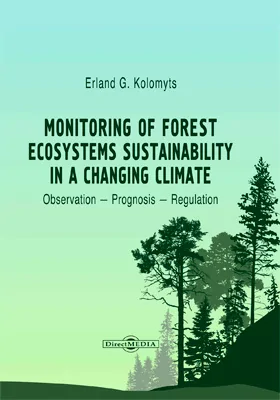
Monitoring of Forest Ecosystems Sustainability in a Changing Climate: Observation — Prognosis — Regulation
Здесь можно купить книгу "Monitoring of Forest Ecosystems Sustainability in a Changing Climate: Observation — Prognosis — Regulation" в печатном или электронном виде. Также, Вы можете прочесть аннотацию, цитаты и содержание, ознакомиться и оставить отзывы (комментарии) об этой книге.
Место издания: Moscow
ISBN: 978-5-4499-4015-5
Страниц: 308
Артикул: 105323
Краткая аннотация книги "Monitoring of Forest Ecosystems Sustainability in a Changing Climate: Observation — Prognosis — Regulation"
The book outlines the new working concept of geo-ecological forest monitoring at the present stage of global warming. For the first time, the full triad of monitoring in its classical definition is considered: «observation (state assessment) — control (prediction) — management (adaptation, feedback, regulation)». The monograph first reports a comprehensive topo-ecological prediction concept as a scientific and methodological basis of local monitoring of natural ecosystems under global climatic changes. The methods of local landscapeecological forecast developed by the author on the basis of empirical-statistical modeling are stated. The complex problem of local and regional response to global climate change, still poorly covered in domestic and foreign literature, has been studied. The mechanisms of local response to the global warming anticipated during the 21st century have been assessed by the example of forest ecosystems of the Volga River basin.The landscape-ecological analysis and forecast were carried out on specific examples, with the involvement of the mass of field factual material collected by the author and with the use of methods of empirical simulation of calculated predicted situations. Forecasts of changes in the biological cycle, including the productivity of forests, are given. Analytical and cartographic models of the functional stability of forest ecosystems are also presented. Quantitative predictive estimates of local and regional regulation of the carbon cycle by forest ecosystems are given for scenarios of modern global warming. One of the possible ways to achieve the environmental goals provided for by the Paris Agreement on climate change has been implemented. An experiment was conducted to numerically solve a dual problem: 1) absorption of CO2 from the atmosphere by forest communities during global warming and 2) their adaptation to these climate changes, which should ensure the effectiveness of the adsorption itself.For students, graduate students and young scientists as an educational and reference tool in the field of landscape ecology, environmental modeling and forecasting.
Содержание книги "Monitoring of Forest Ecosystems Sustainability in a Changing Climate: Observation — Prognosis — Regulation "
Editor’s foreword
Introduction. Subject and objectives of ground geosystem monitoring
List of special terms mentioned in the book
Part I. Working positions of the concept about geosystem forests monitoring
Chapter 1. Advancing the theory and methods of geo-ecological monitoring
1.1. The problem of global changes on the regional and local levels
1.2. Environmentally sustainability
1.3. Scientific and practical significance of monitoring research
1.4. General direction of scientific research
Chapter 2. Landscape-ecological strategy for ground geosystem monitoring of forests
2.1. Current state of the concept of geo-ecological monitoring in a changing climate
2.2. The boreal ecotone of the Russian Plain as a natural «fast-flowing» model of global change
2.3. The scientific and methodological basis of prognostic analysis
2.4. Working algorithm for terrestrial geosystem monitoring
Part II. The first stage of monitoring — observation (status assessment)
Chapter 3. Methods of local and regional landscape-ecological modeling
3.1. Introductory remarks
3.2. General features of landscape-ecological modeling
3.3. Mono-system information-statistical models
3.4. Typical schemes of binary ordination for the component attributes
3.5. Poly-system fuzzy-set-theoretical models
3.6. Integral models of the poly-system organization of natural complexes
3.7. Distinguishing of forest biogeocoenosis ecotypes
Chapter 4. Local geosystems as the initial objects of ground geo-ecological monitoring
4.1. Introductory notes
4.2. Ecological concept in landscape studies and forest typology
4.3. Ground empirical material for modeling
4.3.1. Regional bioclimatic system
4.3.2. Experimental test sites
4.3.3. System of local and regional landscape coupling
4.3.4. Large-scale landscape-ecological surveys
4.4. Parameters of the biological cycle as indicators of ecosystem stability
4.5. The importance of studying local geo(eco-)systems for landscapeecological forecasts
Chapter 5. Forest ecosystem formation mechanisms as a scientific and methodological basis for ground monitoring
5.1. Predictive value of the factor-dynamic analysis of forest ecosystems
5.2. System of chain reactions in inter-component bonds
5.3. The topological mechanisms of space ecosystem organization on the zonal boundary
5.4. Ecological optima of coniferous-forest phytocoenoses in the space of abiotic environmental factors
5.5. Auto-regulation processes in coniferous forest ecosystem
5.6. Plant substance turnover and stability of ecosystems
5.7. Some inferences
Chapter 6. The polyzonality of local geo(eco-)systems as a way of their response to global climate chenge
6.1. Zonality as an object of ecological-geographical investigation
6.2. Subjects and methods of studies
6.3. The system of local connection channels
6.4. The phenomenon of bioclimatic poly-zonality at the local level under conditions of flat relief
6.5. The poly-zonality under conditions of relief close to low mountains
6.6. Some inferences
Chapter 7. Functional ordination of forest ecosystems according to arid climate trend
7.1. Introductory remarks
7.2. Local empirical simulation of the regional bioclimatic trend
7.3. Functioning of geo(eco-)systems as an object of the ecological monitoring
7.4. Hydro-thermal ordination of biological cycle parameters
7.5. Empirical simulation of climate-genic changes in the biological cycle
7.5.1. Autotrophic biogenesis on zonal ecotones
7.5.2. Detritus-genesis
7.5.3. The principle of optimality in the functioning of ecosystems
7.5.4. The driving forces of climate-genic successions
7.6. Prospects for the structural transformation of forest ecosystems under thermo-arid changes in the biological cycle
Chapter 8. Landscape-geophysical foundations for geosystem monitoring of the environment
8.1. The local humidify factors and their significance for ecological prognoses
8.1.1. Issues of the problem
8.1.2. Objects of research and basic materials
8.1.3. Local diversity of the annual atmospheric humidity factor
8.2. Edaphic humidity factor and the method of its calculation
8.3. Local coefficient of common humidification
8.4. Humidity factors and levels of functioning of geo(eco-)systems
8.5. Hydro-edaphic conditions of the critical states of forest ecosystems
8.6. The predictive estimates of edaphic humidity changes and their ecological effects
8.7. The models of spatial organization of forest topo-ecosystems as a basic for local monitoring of global changes
8.7.1. Objects and methods of the research
8.7.2. General system of inter-component relationships
8.7.3. Ecological niches of biogeocoenosis groups
8.7.4. Forest litter as an indicator of ecosystem functioning
Part III. Second stage of monitoring — control (prognosis)
Chapter 9. Peculiarity of landscape-ecological prognoses
9.1. Regional ecology and problem of global changes
9.2. Landscape-ecological system as an object of predictive modeling
9.3. Ideological foundations and strategy of predictive research
Chapter 10. Zonal-regional ecological prognoses
10.1. Empirical grounds of predictions
10.1.1. Empirical landscape-ecological modeling
10.1.2. Zonal-regional characteristics of bioclimatic system
10.2. Analytic methods of landscape-ecological prognoses
10.2.1. Evaluate of probabilities of changes in the functional states of ecosystems
10.2.2. Algorithm of predictive calculations
10.3. Prognoses of landscape-zonal conditions
10.3.1. Representation of calculating climatic models
10.3.2. Main features of climatic prognosis in the region
10.3.3. Prognosis evaluates of state of regional bioclimatic system
10.3.4. Prognostic scenarios of zonal structure of the basin territory
10.4. Dynamics of biological cycle parameters in zonal-regional ecosystems
10.5. Main inference
Сhapter 11. Local lanscape-ecological prognoses
11.1. The ideology of local environmental forecasting
11.2. Prerequisites of research
11.3. Empirical materials
11.4. The main characteristics of climate prediction
11.5. Prediction procedure
11.6. Prognostic scenarios of transformation of forest ecosystems
11.6.1. Changes of the soil moisture content
11.6.2. Climate-genic dynamic of forest biogeocoenoses
11.7. Main inferences
Part IV. Third stage of monitoring — management (adaptation, feedback, regulation)
Chapter 12. Mechanisms of stability of forest ecosystems
12.1. Problem status
12.2. Analytical modeling of the stability of forest biogeocoenoses
12.2.1. Labile phytocoenotic resistance
12.2.2. Inertial soil-biotic stability
12.3. Stability of forest biogeocoenoses in cartographic terms
12.4. Models of stability for forest formations
12.5. Main inferences
Chapter 13. Methods of landscape ecology in prognostic estimation of the biotic regulation of the carbon cycle
13.1. Introductory remarks
13.2. The states of problem
13.3. The landscape-ecological approach to the problem
13.4. The general trends and objectives of research
13.5. Methods of prognostic analysis
13.6. Main inferences
Chapter 14. Carbon balance of forest ecosystems for different climatic trends
14.1. Materials and methods of analysis
14.2. The carbon balance of forest ecosystems predicted for different climatic trends
14.2.1. Analytical predictive modeling
14.2.2. Area-weighted average rates of carbon balances
14.3. Mapping predictive scenarios of the carbon balance
14.4. Main inferences
Chapter 15. Ecological resources of boreal and nemoral forests in regulation of the carbon cycle and mitigation of present global warming
15.1. Adaptation and mitigation is the final stage of geo-ecological monitoring
15.2. The concept of ecological resources of forests in the regulation of the carbon cycle
15.3. Ecological resources of restored primary forests of the Volga River basin
15.4. Anthropogenic changes in the ecological resources of modern forest cover
15.5. Ecological resources of forest formations in conditions of extreme warming
15.6. Carbon balance of forest formations in the system of their thermo-arid transformations
15.7. Verification of predictive calculations of the carbon balance
15.8. Virtual predictive environmental mapping
15.9. Toward the solution of the dual problem of adsorption and adaptation (in accordance with the Paris Agreement)
15.10. Some inferences
Conclusion
Supplement. List of the signs for modeling
References
About the author
Subject index
Все отзывы о книге Monitoring of Forest Ecosystems Sustainability in a Changing Climate: Observation — Prognosis — Regulation
Отрывок из книги Monitoring of Forest Ecosystems Sustainability in a Changing Climate: Observation — Prognosis — Regulation
The ecological role of forests is particularly important, firstly in the forest-deficient regions, which include practically the entire middle belt of the European Russia (Losev, 2001; Korotkov et al., 2020; Maksimiva et al., 2021). The requirement to preserve the reproduction of forest resources at the southern border of the mid-latitude forest zone, where forest communities are in the near-critical states, is among the funda-mental ecological problems (Smirnova, 2004; Zamolodchikov et al., 2014; Gauthier et al., 2015; Kharuk et al., 2016). It has been always of high priority for European Russia, within which there is a vast transition band from forest to steppe, i. e. the boreal ecotone (Kolomyts, 2005; 2018, a, b), is a part of the industrial and demo-graphic “core” of the Russia. It is a rather extensive transition zone from the boreal (predominantly coniferous-forest) belt to the sub-boreal (forest-steppe and steppe) one. Here, the forest formations are under modern hydrothermal conditions close to the critical ones (Bazilevich et al., 1986; Glazovsky et al., 1992; Glazovsky, 2004). The main catchment area of the Volga River basin is to serve as an object of lo-cal and regional monitoring of the sustainable development of forests in the southern margin of the boreal belt of the East European subcontinent under the conditions of modern global climate change. This territory is included in three world centers of extreme anthropogenic destabilization of the natural environment, with the loss of up to 80–90 % of the forest cover area (Table 1.1; Fig. 1.1) and with the dominance of sec-ondary associations (Losev, 2001). Even in the taiga zone of European Russia, by the beginning of the 1990s, slightly more than 60 % of forest areas remained undisturbed. In the remaining Upper Volga-Oka forests, more than 50 % loss of phytomass occurred. Based on processing the recent satellite data from ...
С книгой "Monitoring of Forest Ecosystems Sustainability in a Changing Climate: Observation — Prognosis — Regulation" читают
Внимание!
При обнаружении неточностей или ошибок в описании книги "Monitoring of Forest Ecosystems Sustainability in a Changing Climate: Observation — Prognosis — Regulation = [Коломыц, Е. Г. Мониторинг устойчивости лесных экосистем в условиях меняющегося климата : наблюдение — прогноз — регулирование] (автор Эрланд Коломыц, Erland Kolomyts)", просим Вас отправить сообщение на почту help@directmedia.ru. Благодарим!
и мы свяжемся с вами в течение 15 минут
за оставленную заявку






























